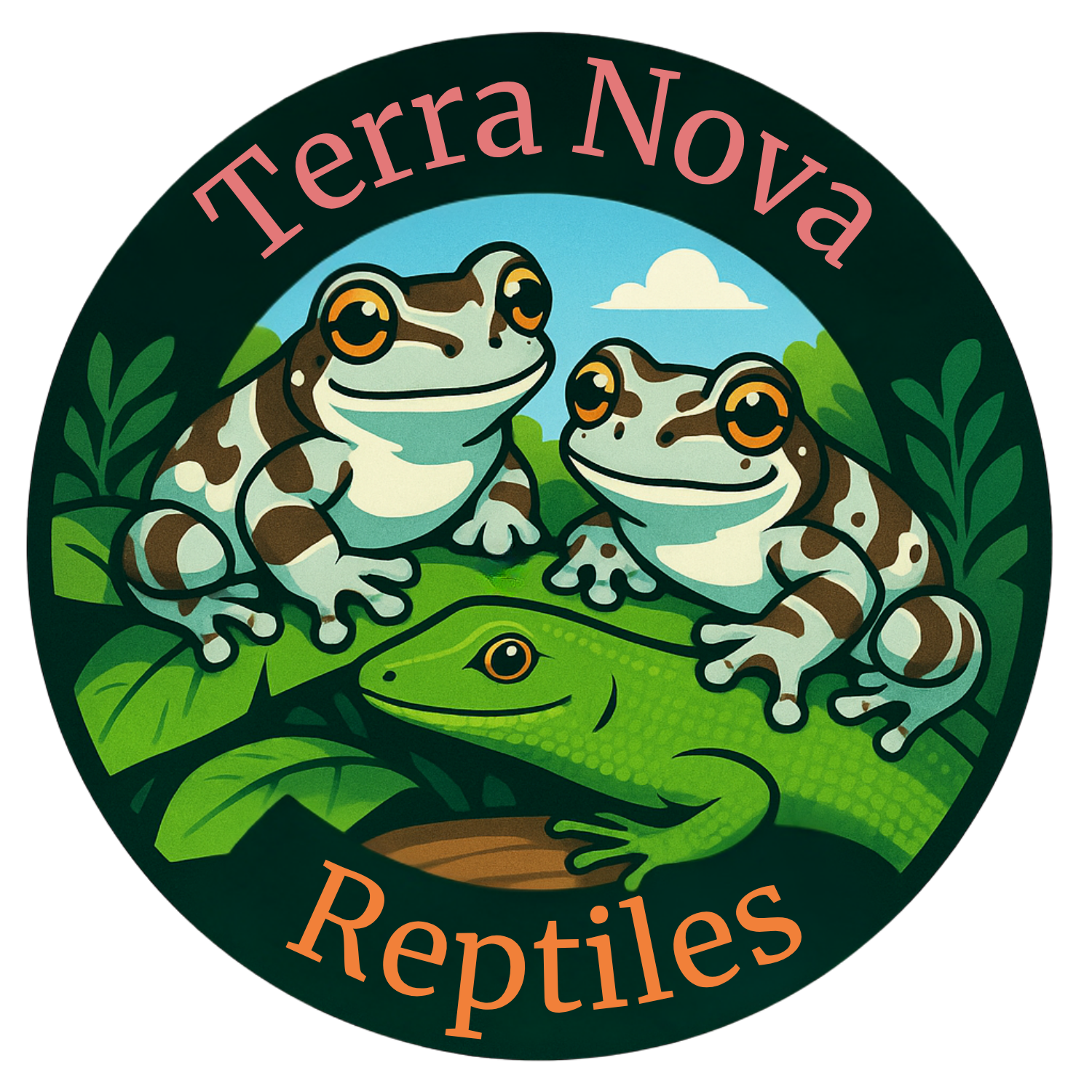The Terra Nova Crew
-

Emerald Tree Skinks (Lamprolepis smaragdina)
The Emerald Tree Skink is a vibrant and agile lizard native to Southeast Asia and the Pacific Islands. Named for its striking green coloration, this arboreal species is known for its sleek body, long tail, and curious, intelligent behavior. Adults typically reach 8–10 inches in length, with slender limbs and sharp claws well-adapted for climbing.
These skinks inhabit tropical forests and coastal areas, where they spend most of their time in trees, basking in sunlight or foraging for insects and fruit. In captivity, they thrive in vertically oriented enclosures with plenty of branches, foliage, and hiding spots that mimic their natural environment.
Emerald Tree Skinks are highly active and social reptiles that can display fascinating behaviors, especially when housed in groups (ideally with proper space and monitoring). While they may be a bit shy at first, with consistent handling and a calm environment, they can become quite interactive and bold.
Known for their intelligence and speed, Emerald Tree Skinks require a well-maintained environment with warm temperatures, high humidity, and UVB lighting to stay healthy. Their diet should include a variety of live insects, supplemented with occasional fruits and calcium/vitamin dusting.
With their dazzling appearance and energetic personality, Emerald Tree Skinks make rewarding pets for intermediate to experienced reptile keepers who are prepared to meet their environmental and behavioral needs.
Our Current Family:
- 1 unsexed baby born June 2025
- 1 unsexed baby born April 2025
- 1 unsexed baby born ~ January 2025
- 1 male born January 2024 -

Amazon Milk Frogs (Trachycephalus resinifictrix)
The Amazon Milk Frog, also known as the Mission Golden-Eyed Tree Frog, is a stunning arboreal amphibian native to the Amazon Rainforest, primarily in Brazil and surrounding regions. Its common name comes from the milky, white secretion it produces when stressed—a natural defense mechanism against predators.
These frogs are known for their striking appearance: soft gray to pale blue bodies adorned with dark brown or black banding, and large golden or bronze eyes. Juveniles are often more vibrantly colored and develop a more muted tone as they mature. Adults can grow to around 2.5 to 4 inches in length and are generally long-lived for amphibians, often living over 10 years in captivity with proper care.
Amazon Milk Frogs are arboreal by nature, spending much of their time in the treetops. In captivity, they require a vertically oriented enclosure with plenty of climbing branches, live or artificial plants, and secure hiding areas. High humidity (around 70–90%), consistent misting, and proper ventilation are key to their health, along with daytime temperatures in the mid-70s to low 80s °F and a slight drop at night.
Their diet consists mainly of appropriately sized, gut-loaded insects such as crickets, roaches, and occasionally small worms or flies. Calcium and vitamin supplementation is essential for long-term health.
Docile and relatively easy to care for compared to other tree frogs, Amazon Milk Frogs are a great choice for amphibian enthusiasts. While they shouldn’t be handled often due to their sensitive skin, they can become quite active and entertaining to observe, especially during the evening hours.
-

Giant Day Geckos (Phelsuma grandis)
The Giant Day Gecko is one of the most iconic and visually stunning gecko species in the world. Native to the tropical forests of northern Madagascar, this large diurnal (day-active) gecko is known for its vibrant lime green body, bright red markings, and striking blue or turquoise accents—making it a favorite among reptile enthusiasts and nature lovers alike.
Adults typically grow between 8 to 12 inches in length, making them the largest of the day geckos. Their adhesive toe pads allow them to climb smooth surfaces with ease, and their expressive, curious behavior makes them a joy to observe. However, Giant Day Geckos are best admired, not handled, as their skin is delicate and they can be easily stressed by frequent contact.
In captivity, these geckos thrive in vertically oriented enclosures with ample climbing space, live plants, cork bark, and bamboo. They require warm daytime temperatures (80–88°F), UVB lighting, and moderate to high humidity (60–80%) to stay healthy and active. A basking area and a slight temperature drop at night will help mimic their natural environment.
Their diet is omnivorous, consisting of a variety of gut-loaded insects (like crickets, dubia roaches, and flies) and specially formulated fruit or nectar-based gecko diets. In the wild, they also consume pollen, nectar, and soft fruits, which should be replicated in captivity for optimal nutrition.
Giant Day Geckos are intelligent, alert, and full of personality. While not ideal for handling, they are excellent display animals and do well in bioactive enclosures where their natural behaviors can truly shine. With proper care, they can live 10–15 years in captivity.

